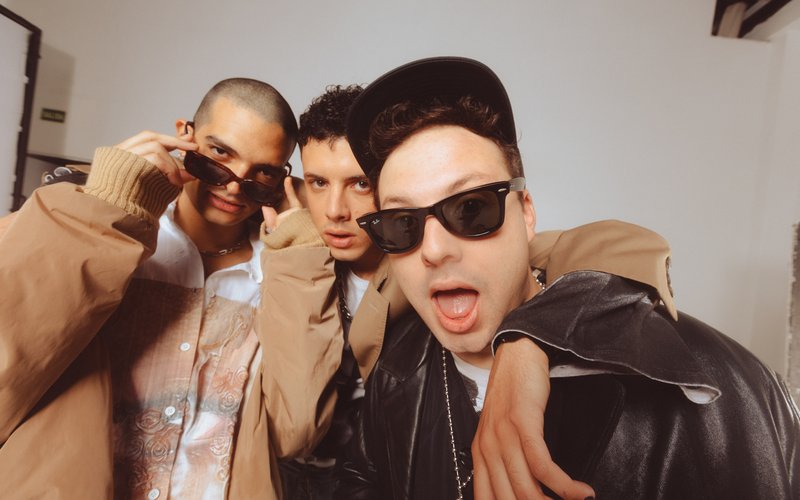
On July 21, KEXP will host El Sonido Live, a free concert in KEXP’s courtyard celebrating Ibero-American music and community. As we lead up to the event, we’re getting to know the artists performing a bit better. In the spirit of our El Sonido: Cancioneros podcast, we’re asking artists to talk through their personal songbooks by sharing three albums that have inspired them.
Argentine band Usted Señalemelo bring an thrilling fusion of indie rock, synth-heavy dance beats, and songs packed with infectious melodies. Each member shares an album that gives us amazing insight into how their sounds came to be – from the legendary work of Luis Alberto Spinetta and Gustavo Cerati, the traditional tonada folk music of Ernesto Hidro Advicencio, as well as some inspiration from Seattle's own Nirvana. Read more about their picks below.
Learn more about El Sonido Live.
KEXP: Juan, you picked Luis Alberto Spinetta’s Pelusón of Milk. Spinetta is a legend of the Argentina rock scene. Can you talk a bit about his influence and why you picked his album?
Juan Mango: Spinetta is my favorite Argentine artist – in the world, even. His legacy is my greatest inspiration in every sense (as a musician, writer, designer, in every band he had, and as a human being). I have been listening to him since I can remember. For example, I remember that a cassette of "Invisible" was playing in my parents' workshop while they worked. When I was around 10 years old, "Seguir viviendo sin tu amor" played on the radio, and I asked my mom who sang that song, and she replied, "It's El Flaco, son." A few days later, we found this album in a record store, which has the song I had heard on the radio, and since that day, Pelusón of Milk has accompanied me. In some way, Luis synthesized rock and tango in his artistic world; this resonates with the porteño legacy of my family tree. I recommend listening to and studying Luis Alberto Spinetta!
KEXP: Luca, you picked Gustavo Cerati’s Siempre Es Hoy. You’re the second artist we’ve talked to who picked a Gustavo Cerati album (Pahua mentioned Bocanada). Can you talk about the significance of his work and what draws you to this album in particular?
Lucca Beguerie Petrich: Well, basically, I chose Gustavo Cerati's Siempre Es Hoy because it's one of the albums that marked my childhood, one of the albums I listened to the most when I was a kid. It not only marked me musically but also visually because of the videos that album had, the cover, everything that happened in that context. It's a quite peculiar and long album. I remember finding it crazy that it was so long and had so many different genres, the mix of electronic and rock, the sounds of the drums. It's an album that left a mark on me, and I still listen to it a lot today, finding inspiration in its songs, which continue to give me things. It's a... well, quite... quite unusual album within Cerati's facet, like all his albums that have their own personality and identity. And well, I think the use of sound, mixing, everything, is amazing. It truly seems like a very ahead-of-its-time album, which still sounds modern today, and if it were released today, it would fit perfectly.
KEXP: Gabriel, I’m very interested in your pick of Ernesto Villavicencio’s Folklore cuyano. There’s not much information about him or his music out there but it’s really beautiful. Could you tell me how you came across his album and what this album means to you?
Gabriel Orozco: Well, I chose Ernesto Hidro Advicencio's album Folklore Cuyano, which is a compilation of his best tonadas. Tonada is a rhythm from Mendoza, in the western region of Argentina known as Cuyo, where we come from. It's an album that I really like because my parents also love it. It represents the folklore of that region. He’s from the province of San Luis, and it's like the deep folklore of the western part of Argentina. It has many songs that my parents used to sing to me when I was a child, and they really move me. I think they have a beautiful musical and lyrical quality, so that's why I chose it. He's not widely known, but he's a musician I greatly admire.
What are your impressions of Seattle? Have any of you been here before? What do you associate with the city?
Juan Mango: Personally, I don't know Seattle, and I have never been here. The only thing I know is Kurt [Cobain]. In adolescence, an uncle gave me an MP3 filled with music, and among those songs were several by Nirvana. Although I didn't connect at that moment, a few years ago, I rediscovered Kurt. He is truly a singer who moves me when he screams (like [John] Lennon, like Spinetta, like Archy Marshall or Nicholas Albrook). When Kurt sings, he manages to communicate all his sensitivity, and I admire that about him. During the quarantine, I studied several of his compositions, and indirectly, his essence is present in TRIPOLAR (and therefore, the essence of Seattle).
What are your favorite Live on KEXP sessions?
Juan: My favorite KEXP live session is POND's. I remember watching it among the three of us, including our brothers Simon and Bruno (from the band Perras on the Beach). KEXP has academically shaped us when it comes to watching shows of the artists we admire the most!
Rubio discusses favorite records from Radiohead and PJ Harvey ahead of her performance at El Sonido Live on July 21
Helado Negro opens his songbook and his memories as a Latinx person raised in the United States, breaking down monolithic barriers surrounding Latinness.
Pahua discusses favorite records from Massive Attack and Bomba Estéreo ahead of her performance at El Sonido Live on July 21